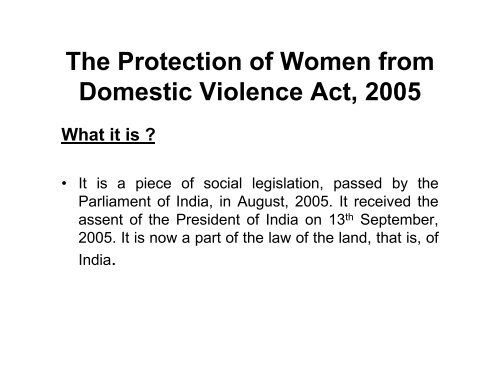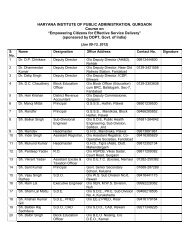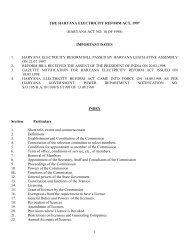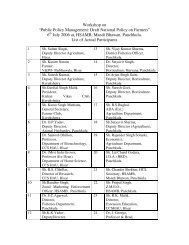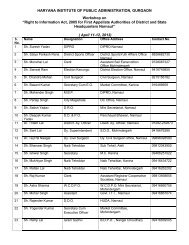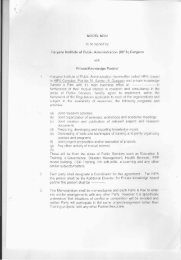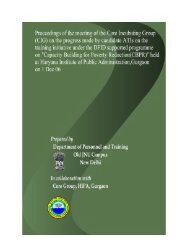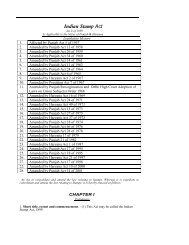The Protection of Women from Domestic Violence Act, 2005 - HIPA
The Protection of Women from Domestic Violence Act, 2005 - HIPA
The Protection of Women from Domestic Violence Act, 2005 - HIPA
- No tags were found...
Create successful ePaper yourself
Turn your PDF publications into a flip-book with our unique Google optimized e-Paper software.
<strong>The</strong> <strong>Protection</strong> <strong>of</strong> <strong>Women</strong> <strong>from</strong><strong>Domestic</strong> <strong>Violence</strong> <strong>Act</strong>, <strong>2005</strong>What it is ?• It is a piece <strong>of</strong> social legislation, passed by theParliament <strong>of</strong> India, in August, <strong>2005</strong>. It received theassent <strong>of</strong> the President <strong>of</strong> India on 13 th September,<strong>2005</strong>. It is now a part <strong>of</strong> the law <strong>of</strong> the land, that is, <strong>of</strong>India.
2. Its objectTo protect women <strong>from</strong> domestic violence.2.1. Not that there was no law in India earlierdealing with violence against women.2.2. <strong>The</strong> previous law, however, was notspecific to domestic violence againstwomen.2.3. <strong>The</strong>refore it was not very effective incontrolling violence committed againstwomen, within the family or inside thehousehold.
3. Commencement <strong>of</strong> the <strong>Act</strong>.This <strong>Act</strong> came into force on 26 th October 2006.4. Extent <strong>of</strong> operationIt extends to the whole <strong>of</strong> India, except the State<strong>of</strong> Jammu and Kashmir
5. <strong>Domestic</strong> <strong>Violence</strong> – its literal meaningSimply speaking, it means violence committedby a member <strong>of</strong> the family against anothermember.5.1. Here, the term “domestic” has been used asan adjective. It pertains to home, family,household, private and the like.5.2 <strong>Violence</strong> within the family or inside thehousehold, between parties, who are in intimaterelationship with each other, is commonly called“<strong>Domestic</strong> <strong>Violence</strong>”.
6.<strong>Domestic</strong> <strong>Violence</strong> under the <strong>Act</strong><strong>The</strong> expression “<strong>Domestic</strong> <strong>Violence</strong>”defined in see 3 <strong>of</strong> the <strong>Act</strong>.has been6.1 It is very comprehensive. It embraces wide range<strong>of</strong> wrongs.6.2 Roughly it includes physical injury, mental harm,sexual harassment, economic exploitation,emotional abuse and many acts <strong>of</strong> commissionsand omissions rooted in gender discrimination,inequality, subordination and injustice.
6.3 <strong>The</strong> <strong>Act</strong> does not, however, cover all kinds <strong>of</strong>violence against women. <strong>The</strong> violence, to bewithin the meaning <strong>of</strong> the <strong>Act</strong>, has to fulfil certainconditions, namelyi. the victim must be a womanii. the violence should be committed by aniii.adult male person.<strong>The</strong>re should exist domestic relationshipbetween the two persons, namely theaggrieved woman and the allegedperpetrator <strong>of</strong> violence.Note : the violence against the children under thecare and custody <strong>of</strong> the victim woman isalso covered by the <strong>Act</strong>.
7. Reliefs available under the <strong>Act</strong> :-i) <strong>Protection</strong> order (sec. 18)ii) Residence order (sec. 19)iii) Monetary Relief (sec. 20)iv)Custody order (sec. 21)v) Compensation order (sec. 22)(vi)Interim and ex parte order (sec. 23)
8. <strong>The</strong> Authority competent to grant suchreliefsAll the reliefs specified in para (7) above may begranted by the same Authority, namely JudicialMagnitude, First class or the MetropolitanMagistrate, as the case may be9. <strong>The</strong> facilities provided under the <strong>Act</strong>i. Medical facilities (sec. 7)ii. Shelter homes (sec. 8)iii. Counselling (sec. 14)iv. Assistance <strong>of</strong> welfare experts (sec. 15)v. Support by <strong>Protection</strong> Officers, Police Officerand Service Providers (sections 4, 5, 8, 9 and10)
10. Proceedings under the <strong>Act</strong> for reliefsIt may be initiated by an application addressed tothe Magistrate (see 12).10.1 <strong>The</strong> application may be made by anaggrieved person, or <strong>Protection</strong> Officer or any personon behalf <strong>of</strong> the aggrieved person , seeking one ormore reliefs.10.2 <strong>The</strong> Magistrate, within three days <strong>from</strong> thedate <strong>of</strong> receipt <strong>of</strong> the application should fix the firstdate <strong>of</strong> hearing..10.3 Service <strong>of</strong> the notice to the Respondent,that is, the person (adult male) against whomallegation <strong>of</strong> domestic violence has been made.
10.4 Counselling <strong>from</strong> and assistance <strong>of</strong> thewelfare expert may be availed, if theMagistrate thinks it fit to do so.10.5. <strong>The</strong> proceedings may be held in camera(sec. 16.).Note : Camera really means the chamber <strong>of</strong> the Judge(here the Magistrate) where proceedings may beconducted, excluding public and maintaining secrecy.10.6: Hearing <strong>of</strong> the parties – reasonableopportunity to both sides <strong>of</strong> being heard.10.7 Grant <strong>of</strong> relief, if and when the Magistrate issatisfied that a case <strong>of</strong> domestic violence, actualor threatened, has been made out.
11. Nature <strong>of</strong> the reliefs under the <strong>Act</strong>:It is civil in nature and not criminal.11.1 : <strong>The</strong> object <strong>of</strong> Civil Justice is theenforcement <strong>of</strong> rights, while that <strong>of</strong>criminal justice is punishment <strong>of</strong> the<strong>of</strong>fenders.11.2 : <strong>The</strong> <strong>Act</strong> <strong>of</strong>fers remedy for the wrong <strong>of</strong>domestic violence, by providing easyaccess to justice mechanism insisting onsimplicity <strong>of</strong> procedures and urging uponexpeditious hearing.
12. Satisfaction <strong>of</strong> the Magistrate andstandard <strong>of</strong> pro<strong>of</strong>.It is pre-ponderance <strong>of</strong> probability and not pro<strong>of</strong>beyond reasonable doubt.12.1 : <strong>The</strong> standard <strong>of</strong> pro<strong>of</strong> is the same as incivil cases. <strong>The</strong> weight <strong>of</strong> evidence tiltsthe balance in favour <strong>of</strong> which party – isthe point to be decided.12.2 For passing protection orders, theMagistrate ought to be prima faciesatisfied.12.3. Prima facie literally it means “on the face<strong>of</strong> it” or “at first sight.”12.4. In law, “prima facie evidence” is generallytaken as equivalent to “sufficientevidence”.
12.5 “Prima Facie Case” is a caseestablished by sufficient evidence,which would stand out, if notrebutted by the evidence to thecontrary.
13. Enforcement <strong>of</strong> <strong>Protection</strong> Orders passed by theMagistrate u/s-18 Violation <strong>of</strong> protection order is an<strong>of</strong>fence u/s 31 (1).13.1 It is cognizable and non-bailable13.2 <strong>The</strong> sole testimony <strong>of</strong> the aggrieved person, maybe the basis for conviction <strong>of</strong> the accused, if notoverthrown by the evidence to the contrary.13.3 Prosecution and punishment <strong>of</strong> the violator <strong>of</strong> theprotection order is a co-ercive method <strong>of</strong> itsenforcement.13.4 <strong>The</strong> protection order shall remain in force till it iscomplied with or the aggrieved person says that itis no longer required, that is, when she applies fordischarge vide Sec. 25.13.5 <strong>The</strong> Magistrate may direct the <strong>of</strong>ficer-in-charge <strong>of</strong>the Police Station concerned to assist in theimplementation <strong>of</strong> the protection order.
14. Offences created under the <strong>Act</strong>:14.1 : Violation <strong>of</strong> <strong>Protection</strong> Order (VideSec. 31 (1) ) is an <strong>of</strong>fence.14.2 Not discharging duties by the <strong>Protection</strong>Officers, without any sufficient course, asdirected by the Magistrate in the<strong>Protection</strong> Order is another <strong>of</strong>fence (Sec.33).14.3 sub para 14.3 no. prosecution against a<strong>Protection</strong> Officer unless a complaint isfiled with the sanction <strong>of</strong> the StateGovernment or an <strong>of</strong>ficer authorised by it.
15. <strong>The</strong> <strong>Act</strong> is not in derogation <strong>of</strong> any other law(vide Section 36). It means that the <strong>Act</strong> provides foradditional reliefs, apart <strong>from</strong> the remedies availableunder any other law, civil or criminal and does notstand in the way <strong>of</strong> invoking any other legal remedy.
16. Salient Features <strong>of</strong> the <strong>Act</strong>:(i)(ii)(iii)It seeks to protect a woman <strong>from</strong> domesticviolence committed or threatened to becommitted, by an adult male member <strong>of</strong>the family or household.It recognizes the right <strong>of</strong> the aggrievedwoman to reside in the sharedhousehold.Aggrieved woman may directly apply tothe Magistrate for appropriate reliefs.
iv.(v)She may also approach the Magistrate through otheragencies, such as <strong>Protection</strong> Officer, Police Officer orService Provider.<strong>The</strong> role <strong>of</strong> the NGOs as Service Providers has beenacknowledged in the <strong>Act</strong> itself.(vi) A strong support system has been created in favour <strong>of</strong> theaggrieved woman.(vii) It is for the <strong>Protection</strong> Officer, Police Officer or a ServiceProvider to aid and assist the aggrieved or affectedwoman, in seeking appropriate reliefs under the <strong>Act</strong> and toensure that the benefits flowing out <strong>of</strong> the <strong>Act</strong> are actuallymade available to her.(viii) Aggrieved woman has a right to be informed <strong>of</strong> thefacilities and services that may be available, specially withrespect to legal aid, safe shelter, medical facility, etc.
(ix)(x)(xi)It provides for counselling, which may pave the way forproper perspective or reconciling attitude.It lays down scope for securing the services <strong>of</strong> welfareexperts.<strong>The</strong> <strong>Act</strong> insists on speedy disposal <strong>of</strong> cases and for whatpurpose, has fixed time-limits. For termination <strong>of</strong> variousstages <strong>of</strong> legal process Sec. 12 (4) Sec 12 (5).(xii) <strong>The</strong> <strong>Act</strong> provides for many remedies which an aggrievedwoman may need – protection, shelter, custody <strong>of</strong>children, medical facility, legal aid, compensation,restoration <strong>of</strong> property, and monetary reliefs.(xiii)<strong>The</strong> <strong>Act</strong> prefers sensitized personnel for itsimplementation. That is why it leans in favour <strong>of</strong> activeparticipation <strong>of</strong> the women in the capacity <strong>of</strong> <strong>Protection</strong>Officers and also as welfare experts for being moregender-sensitive.
(xiv)<strong>The</strong> <strong>Act</strong> provides for remedies under the CivilLaw and at the same time, creates two penal<strong>of</strong>fences.(xv) While the <strong>Act</strong> seeks to punish <strong>Protection</strong> <strong>of</strong>ficersfor dereliction <strong>of</strong> duties, it intends to protectthem <strong>from</strong> false or frivolous complaints. <strong>The</strong>ycannot be prosecuted without any sanction <strong>of</strong> theState Government. That apart, action taken bythem in good faith is protected (Sec. 35).(xvi) All proceedings under the <strong>Act</strong> for obtainingreliefs and also for trial <strong>of</strong> <strong>of</strong>fences are to begoverned by the Code <strong>of</strong> Criminal Procedure.<strong>The</strong> Magistrate may, however, evolve his ownprocedure in two situations u/s 12 and u/s 23 (2).
(xvii)(xviii)(xix)(xx)<strong>The</strong>re are provisions in the <strong>Act</strong>,empowering the Magistrate to passinterim or ex parte orders. He may dealwith emergent situations, as and whenthey may so require.<strong>Protection</strong> Officers and members <strong>of</strong> theService Providers shall be deemed to bepublic servants (Sec 30).Both the <strong>of</strong>fences created under the <strong>Act</strong>are cognizable and non-bailable.Orders passed by the Magistrate maysubsequently be rescinded or modified ifthe circumstances so require. That kind <strong>of</strong>flexibility has been in-built in the <strong>Act</strong>itself.
(xxi) <strong>The</strong> Magistrate is under an obligation to give copies <strong>of</strong> hisorders to the parties, <strong>of</strong>ficer-in-charge <strong>of</strong> the Police Stationsand Service Providers (if associated) free <strong>of</strong> cost.(xxii) <strong>The</strong> <strong>Act</strong> contemplates that all the agencies, namely,<strong>Protection</strong> Officers, Police Officers and Service Providers,should act in harmony in furtherance <strong>of</strong> its objectives.(xxiii) <strong>The</strong> speciality <strong>of</strong> the <strong>Act</strong> lies not only in empowering aJudicial Officers (JM, Ist class or M.M.) to deliver justice ata single window and under the same ro<strong>of</strong> but also increating a separate agency, namely cadre <strong>of</strong> protection<strong>of</strong>ficers and making it mandatory for them to renderassistance and to extend support to the victim <strong>of</strong> domesticviolence, towards giving them what are due to them.
(xxiv)(xxv)Involvement <strong>of</strong> the NGOs in the area <strong>of</strong>implementation <strong>of</strong> the act is anotherimportant strategy adopted by theparliament through this legislation, NGOsmay get themselves registered as “ServiceProviders” and once they do so, theyderive certain powers and obtain a degree<strong>of</strong> immunity, as laid down in section 10(2).<strong>The</strong> <strong>Act</strong> also relies up on Police Officersand imposes upon them specific duties toperform in promotion <strong>of</strong> its goal, inaddition to their obligation to deal withcognizable <strong>of</strong>fences.


